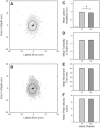On the contributions of vision and proprioception to the representation of hand-near targets
- PMID: 25339706
- PMCID: PMC4297783
- DOI: 10.1152/jn.00005.2014
On the contributions of vision and proprioception to the representation of hand-near targets
Abstract
Performance is often improved when targets are presented in space near the hands rather than far from the hands. Performance in hand-near space may be improved because participants can use proprioception from the nearby limb and hand to provide a narrower and more resolute frame of reference. An equally compelling alternative is that targets appearing near the hand fall within the receptive fields of visual-tactile bimodal cells, recruiting them to assist in the visual representation of targets that appear near but not far from the hand. We distinguished between these two alternatives by capitalizing on research showing that vision and proprioception have differential effects on the precision of target representation (van Beers RJ, Sittig AC, Denier van der Gon JJ. Exp Brain Res 122: 367-377, 1998). Participants performed an in-to-center reaching task to an array of central target locations with their right hand, while their left hand rested near (beneath) or far from the target array. Reaching end-point accuracy, variability, time, and speed were assessed. We predicted that if proprioception contributes to the representation of hand-near targets, then error variability in depth will be smaller in the hand-near condition than in the hand-far condition. By contrast, if vision contributes to the representation of hand-near targets, then error variability along the lateral dimension will be smaller in the hand-near than in the hand-far condition. Our results showed that the placement of the hand near the targets reduced end-point error variability along the lateral dimension only. The results suggest that hand-near targets are represented with greater visual resolution than far targets.
Keywords: attention; frames of reference; motor control; multisensory integration; peripersonal space; sensory resolution; visual processing.
Copyright © 2015 the American Physiological Society.
Figures






References
-
- Abrams R, Davoli C, Du F, Knapp Paull D W. Altered vision near the hands. Cognition 107: 1035–1047, 2008. - PubMed
-
- Bernier PM, Grafton ST. Human posterior parietal cortex flexibly determines reference frames for reaching based on sensory context. Neuron 68: 776–778, 2010. - PubMed
-
- Brainard DH. The psychophysics toolbox. Spat Vis 10: 433–436, 1997. - PubMed
-
- Brown LE, Kroliczak G, Demonet J, Goodale MA. A hand in blindsight: hand placement near target improves size perception in blind visual field. Neuropsychologia 46: 786–802, 2008. - PubMed
-
- Brown LE, Morrissey B, Goodale MA. Vision in the palm of your hand. Neuropsychologia 47: 1621–1626, 2009. - PubMed
Publication types
MeSH terms
LinkOut - more resources
Full Text Sources
Other Literature Sources
Medical

